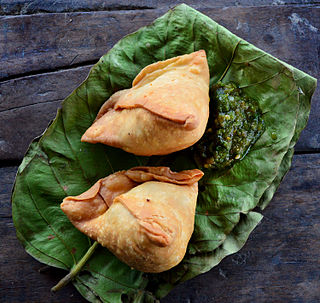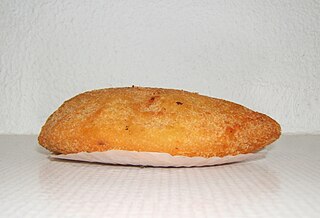
Wagga Wagga is a major regional city in the Riverina region of New South Wales, Australia. Straddling the Murrumbidgee River, with an urban population of more than 71,241 as of 2023, Wagga Wagga is the state's second largest inland city after Maitland, and is an important agricultural, military, and transport hub of Australia. The ninth largest inland city in Australia, Wagga Wagga is located midway between the two largest cities in Australia—Sydney and Melbourne—and is the major regional centre for the Riverina and South West Slopes regions.

A samosa is a fried South Asian pastry with a savoury filling, including ingredients such as spiced potatoes, onions, peas, meat, or fish. It may take different forms, including triangular, cone, or half-moon shapes, depending on the region. Samosas are often accompanied by chutney, and have origins in medieval times or earlier. Sweet versions are also made. Samosas are a popular entrée, appetizer, or snack in the cuisines of South Asia, the Middle East, Central Asia, East Africa and their South Asian diasporas.

The Riverina is an agricultural region of south-western New South Wales, Australia. The Riverina is distinguished from other Australian regions by the combination of flat plains, warm to hot climate and an ample supply of water for irrigation. This combination has allowed the Riverina to develop into one of the most productive and agriculturally diverse areas of Australia. Bordered on the south by the state of Victoria and on the east by the Great Dividing Range, the Riverina covers those areas of New South Wales in the Murray and Murrumbidgee drainage zones to their confluence in the west.

The fig roll or fig bar is a biscuit or cookie consisting of a rolled cake or pastry filled with fig paste.

A rissole is a small patty enclosed in pastry or rolled in breadcrumbs, usually baked or deep fried. The filling has savory ingredients, most often minced meat, fish or cheese, and is served as an entrée, main course, or side dish.

In Australia and New Zealand, a meat pie is a hand-sized pie containing diced or minced meat and gravy, sometimes with onion, mushrooms, or cheese and is often consumed as a takeaway food snack.

Four'n Twenty is an Australian pastry brand, now distributed internationally, with products including meat pies and sausage rolls. It is owned by parent company Patties Foods.

A vol-au-vent is a small hollow case of puff pastry. It was formerly also called a patty case.

The Carniolan sausage is a Slovenian parboiled sausage similar to what is known as kielbasa or Polish sausage in North America.

A meat pie is a pie with a filling of meat and often with other savory ingredients. They are found in cuisines worldwide.
Francis Gerard McEncroe was an Australian publican, caterer, dairy farmer and food manufacturer. He is known for his invention of the Australian fast food phenomenon that became known as the Chiko Roll.

A croquette is a deep-fried roll originating in French cuisine, consisting of a thick binder combined with a filling, which is then breaded. It is served as a side dish, a snack, or fast food worldwide.

Regional street food is street food that has commonalities within a region or culture.

Lumpia are various types of spring rolls from Indonesia and the Philippines. Lumpia are made of thin paper-like or crepe-like pastry skin called "lumpia wrapper" enveloping savory or sweet fillings. It is often served as an appetizer or snack, and might be served deep-fried or fresh (unfried). Lumpia are Indonesian and Filipino adaptations of the Fujianese rùnbǐng and Teochew popiah, usually consumed during Qingming Festival.

Spring rolls are rolled appetizers or dim sum commonly found in Chinese and Southeast Asian cuisines. The kind of wrapper, fillings, and cooking technique used, as well as the name, vary considerably depending on the region's culture, though they are generally filled with vegetables.

A meat-free sausage roll is a savoury pastry snack that contains a non-meat filling. The snack is an alternative to the conventional sausage roll that generally contains pork or beef. Meat-free sausage rolls are sold at retail outlets and are also available from bakeries as a take-away food.
















